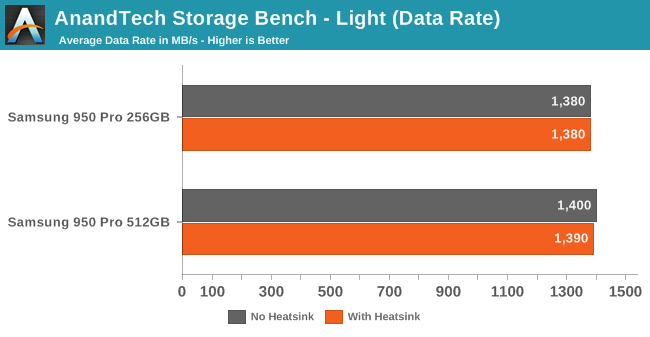The Angelbird Wings PX1 M.2 Adapter Review: Do M.2 SSDs Need Heatsinks?
by Billy Tallis on December 21, 2015 8:00 AM ESTAnandTech Storage Bench - Light
Our Light storage test has relatively more sequential accesses and lower queue depths than The Destroyer or the Heavy test, and it's by far the shortest test overall. It's based largely on applications that aren't highly dependent on storage performance, so this is a test more of application launch times and file load times. This test can be seen as the sum of all the little delays in a day's usage, but with idle times trimmed to 25ms it takes less than half an hour to run. Details of the Light test can be found here.

The read-oriented nature of the Light test allows the 950 Pro to show off its throughput capabilities, with an average data rate more than three times what any SATA drive has achieved. But with frequent idle times and not many writes, this test does nothing to make the 950 Pro overheat and the heatsink makes no difference.


The latency charts show virtually identical performance except for the number of 10ms+ outliers experienced by the 256GB drive. But on a test this short, that amounts to only about 16 more outliers and only 30ms difference in the total run time of the test. I'm actually surprised we're not seeing bigger random variation between runs.










69 Comments
View All Comments
Ryan Smith - Monday, December 21, 2015 - link
That is actually correct. The drives are more consistent when they thermally throttle because the controller has plenty of time to catch up. Whereas with a heatsink they're running at full tilt, and sometimes the controller has trouble keeping things consistent.tipoo - Monday, December 21, 2015 - link
Huh, interesting.tipoo - Monday, December 21, 2015 - link
So why is the scenario the exact flip on the 256GB drive? Did it just finish the test sooner?Billy Tallis - Monday, December 21, 2015 - link
During thermal throttling, the 256GB was occasionally stuttering and dropping from 6k IOPS to 2k IOPS. That tanked the consistency score. The 512GB's performance regulation when thermally throttled was basically perfect—during steady state it never deviated from ~6k IOPS.Magichands8 - Monday, December 21, 2015 - link
I really don't get why so many people seem to love M.2 so much. Sure it's convenient for laptops but for just about anything else it's a severely limited form factor restricting capacity and adding heat issues while eating up precious expansion slot space on the motherboard. What I'd really like to see are U.2 SSDs with 10 times the capacity.nwarawa - Monday, December 21, 2015 - link
The performance is obvious plateauing with that heatsink, so it begs the question: what is good enough? I assume it's just the controller that needs to be cooled. Would one of those tiny chipset heatsinks with some thermal tape still see most, if not all, the benefit of this Angelbird heatsink?Billy Tallis - Monday, December 21, 2015 - link
Given sufficient airflow, I think one of those small heatsinks could get the job done. I don't think most M.2 slots or adapters put the drive in a position to receive that much airflow unless your case is already a serious wind tunnel.damianrobertjones - Monday, December 21, 2015 - link
"The M.2 form factor has quickly established itself as the most popular choice for PCIe SSDs in the consumer space. "How do you know this? I'd still rather buy a 950 Pro 2.5" than an M.2. (I do own both though)
moozooh - Monday, December 21, 2015 - link
"PCIe to M.2 adapter"Shouldn't it be "M.2 to PCIe adapter"? Since, you know, it adapts an M.2 device to a PCIe slot but not the opposite.
Billy Tallis - Monday, December 21, 2015 - link
I was looking at it as making a PCIe slot into an M.2 slot into which you'd insert the drive, as opposed to thinking of it as something modifying the drive. I can see how a consumer pairing it with a particular drive would take the other perspective, but to me the adapter is the permanent part of the testbed and the drives are transient occupants.